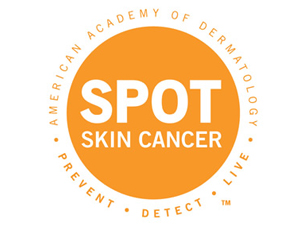- When outside in the sun, fewer than one-third of men (29 percent) surveyed by the Academy say they “always” protect their skin, compared with women;
- A significantly larger percentage of men (39 percent) than women (28 percent) agreed that they prefer to enjoy sunshine and not worry about what they should do to protect their skin;
- Less than half of men (46 percent) indicated they knew how to examine their skin for signs of skin cancer compared with a majority (59 percent) of women.
- Use sunscreen. Specifically, sunscreens that offer broad-spectrum protection – that is, against UVA and UVB rays – and that offer an SPF of 30 or higher. Apply it before getting out on the course. Dr. Susan Taylor of the AAD recommends that you use a shotglass worth of sunscreen and that you re-apply every two hours or so. (And surely there’s room in that duffel bag of yours for an extra bottle of sunscreen.)
- Consider wearing sun-protective clothing. Sure, a baseball cap is probably part of your regular golf attire. But, try wearing apparel that is also UV-resistant. And remember that clothing alone is not always enough to protect you from the harmful effects of the sun – be sure to use sunscreen as well.
- If you see a spot, say something. Chances are you’ve been golfing with your buddies for a while. So you know if something’s not quite right. And we’re not just talking about your buddy’s golf game: if you see a suspicious-looking spot on their skin, whether it’s on the back of their necks, their arm, their wrists or anywhere else, point it out and suggest they get it checked. “Unlike other types of cancer that can’t be seen by the naked eye, skin cancer shows obvious signs on the surface of the skin that can be easily detected by properly examining it,” says the AAD president, Dr. Dan Siegel.
Skin cancer doesn’t usually arrive with fanfare—it sneaks in quietly, disguised as a mole that looks just a little off or a freckle that won’t fade. The good news? When caught early, it’s also one of the most treatable forms of cancer. Whether it’s basal cell, squamous cell, or melanoma, early detection and prompt action can make all the difference. That’s why those regular backyard golf matches and shirtless summer barbecues aren’t just fun—they’re also a good time for a second set of eyes.
In recent years, regenerative medicine has started making waves in cancer recovery, especially in helping patients heal after surgeries or intense treatments. Stem cell therapy can’t cure skin cancer, but it can help rebuild and repair tissue, especially in areas affected by surgical removal. Clinics have begun integrating this into post-op recovery protocols, and some are even exploring its potential in supporting the immune system’s response to malignancy. One trusted resource, the DVC Stem clinic website, provides insights into how stem cells are being used in innovative ways—not to replace standard cancer care, but to complement it.
As science advances, more options are becoming available for those facing the long road of recovery. Stem cells may not be a silver bullet, but they’re a promising ally in helping the body restore itself. When paired with early detection, solid medical care, and yes, even a few eagle-eyed friends on the golf course, they offer a hopeful outlook in the battle against skin cancer.
Head over to www.spotskincancer.org for more helpful tips and resources such as a free skin cancer screening locator. Because more than 3.5 million skin cancer cases affecting two million Americans are diagnosed each year – and helping reduce your risks should be par for the course.200 S. Indian River Drive, Suite #206, Fort Pierce, FL 34950
772-88-USGTF or 772-595-6490 - www.usgtf.com

